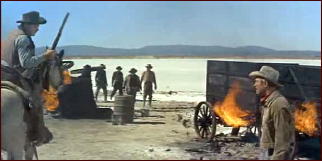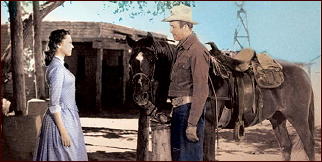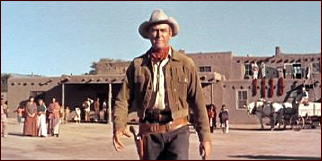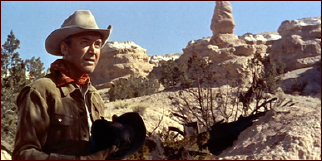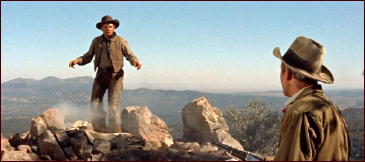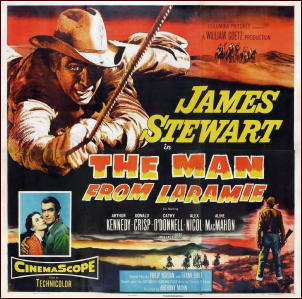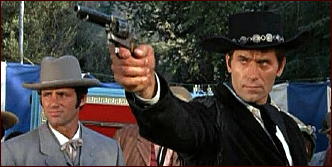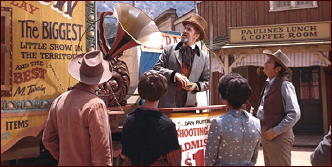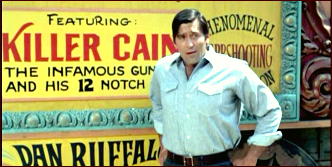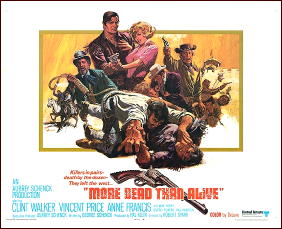Reviewed by DAVID VINEYARD:

THE HILLS RUN RED. C.B. Films S.A., Italy, 1966. United Artists, US, 1967. Original title: Un fiume di dollari. Thomas Hunter, Henry Silva, Dan Duryea, Nando Gazzolo, Nicoletta Machiavelli, Gianna Serra. Screenplay by Dean Craig (Piero Regnoli). Directed by Lee W. Beaver (Carlo Lizziani)
Imagine a Spaghetti Western without the jangling percussive score or the arty cinematography and directorial flourishes and with a more or less standard Western plot from an average lesser A Western of the fifties, and you pretty much have this. The Hills Run Red is a decent minor Spaghetti Western from producer Dino De Laurentiis shot handsomely in color and on more or less classical revenge Western lines, despite some over the top bits you expect of the sub genre.
I would warn you of spoilers from here on, but honestly if you can’t figure this one out you have never seen a Western.
Jerry Brewster (Thomas Hunter) and Cam Siegel (Nando Gazzolo) are ex Confederate soldiers, you can tell by their over the top Southern dubbed accents, who have stolen $600,000 from the U.S. Army and are on the run from pursuing soldiers when just north of the border the Army catches up with them. Brewster loses a game of high card draw and agrees to lead the Army away while Siegel will take the money and promises to take care of Brewster’s son and wife if the latter is captured.

If you don’t see where this is going, you haven’t been paying attention all these years.
Sure enough, Brewster is caught and sent to prison where he spends five years in hard labor and inhuman conditions well illustrated during the titles. When he is finally let go he heads home to find his home deserted (and no wonder he needed the money it is pretty palatial for the post Civil War West) and is promptly ambushed by two killers sent by his old pal Siegel who has been waiting five years. He is saved by the timely help of Winnie Getz (Dan Duryea), an out of work drifter who happens to be sleeping in the remains of Brewster’s barn, and learns from a dying killer that his wife died four years earlier never knowing Jerry Brewster was in prison as Jim Houston or had stolen the money and his son was taken in by Siegel, now known as Milton, who let poor Mary starve to death rather than share the money.
This is accompanied by a half decent song about a golden haired woman.

Either quite a few scenes of connecting material are cut from the film or the screenplay was written during a weekend binge, because no one ever asks questions like what is an aging man doing sleeping in the deserted Brewster barn in the middle of the day in the first place, or why the gun he provides the unarmed Brewster during the battle with the killers only has two bullets.
For that matter why didn’t Duryea’s character just kill the two killers himself? There is an answer, but you have to fill it in for yourself because the screenplay leaves you to guess all the stuff most writers would take the time to fill in. I have to wonder if the screenwriter was a son-in-law or nephew or some other relation of Di Laurentiis, if not I hope he wasn’t allowed to write anything after this.
Brewster swears revenge, and Getz, seeing a chance to get money out of it (exactly how is never explained, but turns out not to matter because … but then I don’t want to give away the big non-surprise), convinces him to play dead while Getz claims to have killed him and gets a job on Milton’s ranch in Austin. There is a fairly nasty scene where they get proof Brewster is dead by carving a tattoo off of his forearm and cauterizing it, but as Spaghetti Westerns go, it is pretty tame. I’ve seen much rougher stuff in American Westerns from a decade earlier. Hell, Gary Cooper lancing the boil on Karl Malden’s ass in Hanging Tree is more disturbing, and its played for laughs.

From there, it is off to Austin where Milton has his ranch, and is pressuring the other ranchers trying to take all the land in standard Western bad guy fashion, aided by his chief henchman Garcia Mendez (Henry Silva) a sadistic hyena of an assassin and ranch foreman in black who covets Mary Anne (Nicoletta Machiavelli) Milton/Siegel’s sister. Apparently it has never occurred to Mary Anne to ask her brother why they had to change their last name, but she frankly never seems very bright anyway. Even by the standard of Spaghetti Westerns, Mary Anne is dumb as a rock.
I won’t even bother with the fact this film is supposed to be taking place in at most the 1870‘s yet everyone is carrying hand guns not in common use for another decade. Those are pet peeves of mine and not really fair to the genre under discussion here.
Brewster, now calling himself Jim Houston, the name he used in prison, shows up and promptly kills two of Mendez men aligning himself with the ranchers and a saloon owner. We are told the sheriff is dead, which still doesn’t explain where the Texas Rangers and Army are, since Austin is the capital of Texas — sorry, keep forgetting it is a Spaghetti Western and they don’t have books in Italy to use for research.

In short order Brewster finds his son Tim (Loris Loddi), living in poverty working for a brutal smith on the Milton ranch, and after proving himself by beating up about eight of Mendez men is befriended by Mendez the cheerful laughing psychopath — you have to wonder Duryea didn’t keep suspecting he was cast in the wrong role, as Silva seems to be playing a Dan Duryea part but as a Mexican bandit.
Of course Milton’s sister has eyes for Brewster (who keeps lingering on the Mary part of her name so we get the connection in case we are as dumb as she is) almost as soon as she sees him setting up a rivalry with Mendez that the screenplay lays on but then promptly forgets to follow up on as it hurries to the finale. Silva tries hard but can’t quite master the Duryea leer — or even the Jack Palance leer. I kept wondering if some of the laughing was directed at himself stuck with this screenplay.
There are a number of big twists in the film that are only twists because the director and screenwriter weren’t familiar enough with the genre to properly set them up. At times it feels as if Di Laurentiis himself must have been shouting at them that they had a movie to make and not to bother with the plot. Quite a few things are never explained and never connected.

Skipping some of the details of the plot, eventually a big gunfight takes place and the two men wipe out Mendez men in one of those over the top Spaghetti Western blood bath gunfights rather dully staged, save Duryea is enjoying not getting killed for once. He, or his stunt man, even gets to jump off a roof onto a bad guy on a horse. You know Duryea must have wanted to be the jumper and not the jumpee in that scene at least once in his career. Brewster then chases Mendez back to the ranch where Henry Silva gets a ridiculous death scene, involving enough lead to sink the Titanic.
We have to hope he was getting paid a ridiculously high salary for this.
Meanwhile a whore (Gianna Serra, who gets the single worst musical number I have ever seen in a Western early on in the film) who helped Mendez trap Brewster by waylaying Tim, has shot Mary Anne when Mendez tried to kidnap his bosses sister and ride away, Mendez has killed the whore/dance hall girl (once you hear her song you know where her talents lie and it an additional motive for Mendez to kill her), and Brewster comforts the wounded Mary Anne before, dressed as Mendez (and I wouldn’t have put those clothes on after putting six or eight holes in Henry Silva), he finally confronts and kills the cowardly Milton (we know he is a coward because earlier he nearly faints at the sight of his own blood) in a decently shot interior gunfight in the dark.
At this point we discover Mary Anne is alive and it looks like she will end up with Brewster and his son Tim (what’s a dead brother among friends), the ranch is turned over to the Army to make up for the lost $600,000, the Army is told Brewster is dead and the now Jim Houston gets a reward and a badge as sheriff of Austin. (But wait, you say, the Army never knew who Brewster was and thought Jim Houston did the crime and the time so why … better still try not to think about it, it’s one of those uncrossed t’s or undotted i’s which abound in this films screenplay.) It’s a happy ending, shut up and enjoy it.
Then there is a twist involving Winnie Getz that is never even hinted at in the film, Getz is Colonel Getz, an undercover Army officer trying to recover the stolen money all this time, explaining quite a few things which the screenplay finds so obvious it leaves for us to guess on our own. Most importantly this allows for possibly the only time in his long career of Westerns for Dan Duryea to not only be proven to be a total good guy, but get to literally ride off into the sunset as a bona fide hero. I admit I wanted to tear up a little at the prospect. It’s one of the few films where he even gets out alive, much less a hero.
Got me right here — I’m tapping my chest, and it isn’t heartburn, though with this film it is hard to tell.
Hunter overacts terribly at times — screaming his dialogue at other actors is his specialty, and it is a wonder Silva didn’t gain weight, he chews so much scenery, come to think of it he looks a little stuffed here, probably all that pasta, those cheekbones are positively rosy. Duryea seems happy to be getting paid for very little and not getting killed for once.
The film is not in a class with any of the Eastwood or Lee Van Cleef films, certainly not most of the Django, Sartana, Nobody or other series, but it is not a bad Western, more like a classic Hollywood type than the ultra violent, cartoonish, and at times psycho sexual Spaghetti Western we know and love. It’s just above a passing grade as such things go, a bit like a shaggy puppy that wins you over by wagging its tail harder than it has to despite knocking over a few lamps in the process.
Jack Elam claimed Henry Fonda called him when they were filming Once Upon a Time in the West and told him to come to Italy, they were paying them for doing nothing. You have to imagine someone told Duryea the same thing.
But for me The Hills Run Red is worth seeing just to see Dan Duryea get to ride away into the sunset. It was a long time coming, and he honestly seems to be enjoying it, I know I did. Way to go, Dan, you made an entire Western without once shooting anyone in the back.
